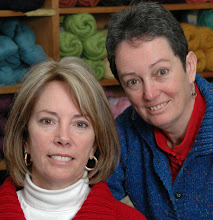My favourite one is what I call an openMake1 (oM1). I use it for raglan increases on my Top Down sweaters for several reasons:
1. It makes a small hole (smaller than a YO).
2. It doesn't lean to the right or left which means I can use the same increase before and after my raglan markers.
3. Working it doesn't interrupt my knitting flow.
4. You can read whether you have worked the increase or not.
Work an OpenM1 by inserting your Right needle from front to back, under the horizontal bar between the stitch just knit and the next stitch,
wrap the yarn as usual to knit a stitch and pull back through. This is just like a pick up and knit.
The beauty of it is that it is just one more knit stitch in your round which you work under the horizontal bar instead of in a stitch on your needle. There's nothing more to it than that. Can you wonder that it's a favourite increase?
The trick when knitting a Top Down Pullover is to recognize, as you approach the raglan marker, whether you have worked an increase or not. A in-the-round pullover is worked with one round where the increases are worked and the next round where you usually knit. If your mind wonders like mine does, you can't always remember what round you are working on when you come to a marker. Do I need to increase or is this a knit round?
When you work the oM1 you use up the horizontal bar between stitches. It's now a stitch. So if you see this, you have worked the increase in the last round. There is no horizontal bar there.
Then you work the oM1 under that horizontal bar because it's there.
In a nutshell, if the horizontal bar is there, you work a oM1, if it's not there you knit.
Enjoy,
Deb

















